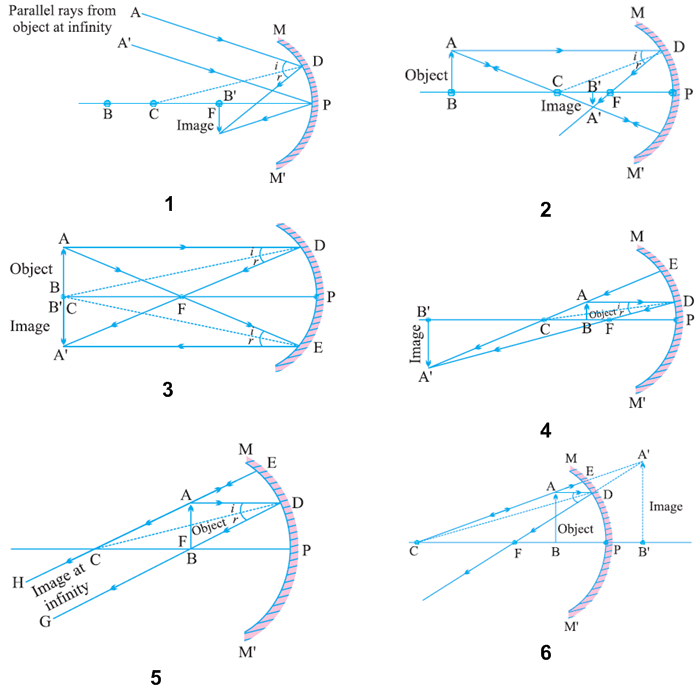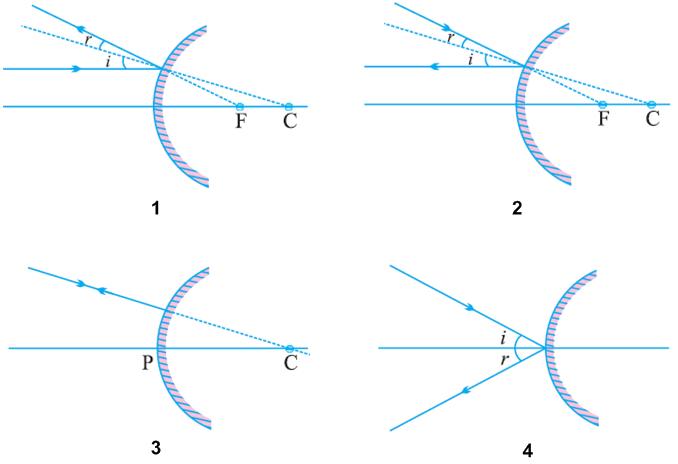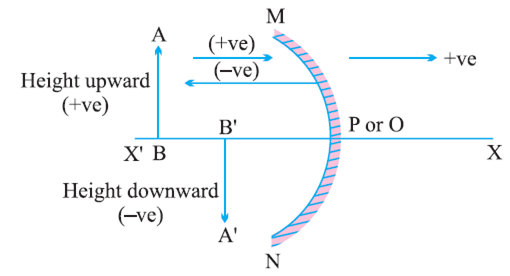CBSE
Class 10 Class 12
The reflecting surface of a spherical mirror may be curved inwards or outwards. A spherical mirror is that mirror whose reflecting surface is the part of a hollow sphere of glass.
The spherical mirrors are of two types: Concave mirror and Convex mirror.
Concave: A concave mirror is that spherical mirror in which the reflection of light takes place at the concave surface (or bent-in surface).
Convex: A convex mirror is that spherical mirror in which the reflection of light takes place at the convex surface (or bulging –out surface).

Centre of Curvature(C): The centre of curvature of a spherical mirror is the centre of the hollow sphere of a glass of which the spherical mirror is a part. It is represented by letter ‘C’.
Pole(P): The pole of a spherical mirror is the centre of the mirror. It is represented by letter ‘P’.
The radius of Curvature(R): The radius of curvature of a spherical mirror is the radius of the hollow sphere of a glass of which the spherical is a part. It is represented by the letter ‘R’.
Principal axis: The principal axis of a spherical mirror is the straight line passing through the centre of curvature C and pole P of the spherical mirror, produced on both sides.
Aperture: The aperture of a spherical mirror is the diameter of the reflecting surface of the mirror.
Focal Length: The focal length of a spherical mirror is the distance between its pole and principal focus. It is denoted by the letter ‘f’.
The relation between Radius of curvature and focal length of a spherical mirror.The focal length of a spherical mirror is equal to half of its radius of curvature.
F = R/2R
R = 2F
Magnification of Spherical Mirrors
It is the ratio of the height of the image to the height of the object.
m = height of image/height of Object
wiris equation require
If ‘m’ is negative, the image is real.
If ‘m’ is positive, the image is virtual.
If hi = ho then m = 1, i.e., image is equal to object.
If hi > hi then m > 1 i.e., image is enlarged.
If hi < ho then m < 1 i.e., the image is diminished.
Magnification of plane mirror is always + 1.
‘+’ sign indicates virtual image.
‘1’ indicates that image is equal to object’s size.
Magnification of Spherical Mirrors
It is the ratio of the height of the image to the height of the object.
m = height of image/height of Object
wiris equation require
If ‘m’ is negative, the image is real.
If ‘m’ is positive, the image is virtual.
If hi = ho then m = 1, i.e., image is equal to object.
If hi > hi then m > 1 i.e., image is enlarged.
If hi < ho then m < 1 i.e., the image is diminished.
Magnification of plane mirror is always + 1.
‘+’ sign indicates virtual image.
‘1’ indicates that image is equal to object’s size.
Rules for making ray diagrams by the concave mirror
Image formation by a concave mirror for different positions of the object
| Position of the object | Position of Image | Size of the Image | Nature of Image |
| At infinity | At the focus F | Highly diminished,point-sized | Real and inverted |
| Beyond C | Between F and C | Diminished | Real and inverted |
| At C | At C | Same size | Real and inverted |
| Between C and F | Beyond C | Enlarged | Real and inverted |
| At F | At infinity | Highly enlarged | Real and inverted |
| Between P and F | Behind the mirror | Enlarged | Virtual and erect |

Uses of the concave mirror:
Rule for image formation by Convex Mirror

Ray diagrams of images formed by convex mirror: Nature, position and relative size of the image formed by a convex mirror
| Position of object | Position of Image | Size of Image | Nature of Image |
| At infinity | At the focus F, behind the mirror | Highly diminished,point-sized | Virtual and erect |
| Between infinity and the pole P of the mirror | Between P and F, behind the mirror | Diminished | Virtual and erect |

Uses of Convex mirrors:
Sign Convention for Reflection by Spherical Mirror or New Cartesian Sign Convention

Object distance = ‘u’ is always negative
Focal length of concave mirror = Negative
Focal length of convex mirror = Positive
Mirror Formula :
where,
v = Image distance
u = Object distance
f = Focal length
Magnification of Spherical Mirrors
It is the ratio of the height of the image to the height of the object.
m = height of image/height of Object
wiris equation require
If ‘m’ is negative, the image is real.
If ‘m’ is positive, the image is virtual.
If hi = ho then m = 1, i.e., image is equal to object.
If hi > hi then m > 1 i.e., image is enlarged.
If hi < ho then m < 1 i.e., the image is diminished.
Magnification of plane mirror is always + 1.
‘+’ sign indicates virtual image.
‘1’ indicates that image is equal to object’s size.